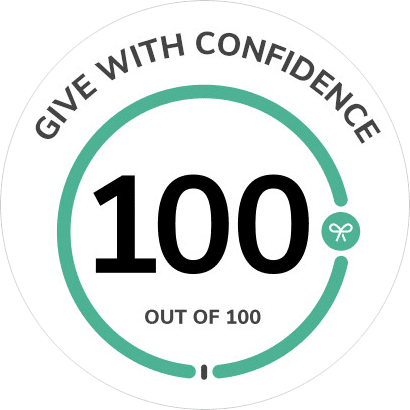The following post is written by United Planet volunteer Jamie Attard, who is currently in Uganda on a Long-Term Quest.
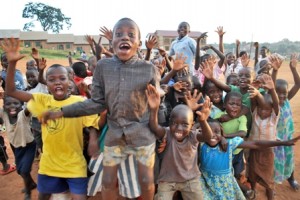 If one was to provide me with a blank canvas and ask me to paint a portrait of Kampala, these are the steps I would follow: I would begin by taking a brush, dipping it into some paint of a light blue hue and with gentle strokes painting the skyline. I would pin a few fluffy clouds in the sky, which here quickly accumulate, release their rain and then disperse to leave mostly clear, bright and warm days for the sun to shine upon. Amongst the clouds I would paint the buzzards, giant birds that soar and circle far above this city looking to feast on any source of meat . Uganda is actually home to over a thousand species of birds that fill the air with constant chirping, but the most noticeable to me are the ever-watchful buzzards. I would then take a dirty rag, one discarded for days on the ground, and smear the skyline in a dirty brown haze. Each morning on my journey to the Institute the small piles of garbage smoldering on the sides of the streets collude with the taxis and trucks that belch their thick diesel fumes to choke the little oxygen that seems to subsist in the air. I clutch for a piece of clothing to cover my mouth in a vain attempt to filter the air, alarmed by the fact that the city skyline, a mere three miles away, is completely enveloped in a thick brown haze.
If one was to provide me with a blank canvas and ask me to paint a portrait of Kampala, these are the steps I would follow: I would begin by taking a brush, dipping it into some paint of a light blue hue and with gentle strokes painting the skyline. I would pin a few fluffy clouds in the sky, which here quickly accumulate, release their rain and then disperse to leave mostly clear, bright and warm days for the sun to shine upon. Amongst the clouds I would paint the buzzards, giant birds that soar and circle far above this city looking to feast on any source of meat . Uganda is actually home to over a thousand species of birds that fill the air with constant chirping, but the most noticeable to me are the ever-watchful buzzards. I would then take a dirty rag, one discarded for days on the ground, and smear the skyline in a dirty brown haze. Each morning on my journey to the Institute the small piles of garbage smoldering on the sides of the streets collude with the taxis and trucks that belch their thick diesel fumes to choke the little oxygen that seems to subsist in the air. I clutch for a piece of clothing to cover my mouth in a vain attempt to filter the air, alarmed by the fact that the city skyline, a mere three miles away, is completely enveloped in a thick brown haze.
Cleaning the brush, I would then use a multitude of green shades to represent the undulating hills that make up the topography of Kampala. In fact, Kampala started as a planned city stretched across seven hills. But it has never been able to cope with the swell of people migrating from the rural areas in search of wealth over the last three decades. Picture a water balloon, initially designed to comfortably hold a body of water necessary for a particular period of time, and then that same balloon being rapidly filled to ten times its capacity. Such a balloon, bursting at the seams, leaks springing all over the place, unable to manage the sheer overcapacity, is Kampala. Today the city spans twenty-four hills with the wealthy perched on top and provided beautiful views of neighboring Lake Victoria, while the poor struggle to survive at the bottom in slum areas primarily amongst wetlands. In a city of 1.5 million people, over 60% live in slum areas, 36% aren’t served by sewers, and in many areas functional latrine coverage is below 50%. 40% don’t have access to safe and clean water and only 39% of the garbage generated is collected and transported to a landfill site.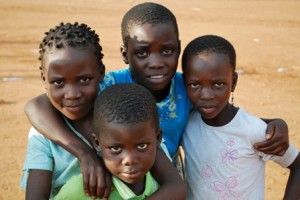
From a distance it is easy to be deceived by the apparent beauty of your surroundings. Uganda offers a verdant and fertile land that is hungry for seeds and eager to quickly return fruit and vegetables of proportions unimaginable. Who needs genetic engineering when this country produces bananas, avocadoes, pineapples, grapes and a variety of other produce twice the size and a number of times better tasting than what we consume in the Western world. In fact half the land in Kampala is used for agriculture, farming provides the primary source of income for over 80% of the population and agriculture contributes almost half of the country’s GDP. Underneath the trees and amongst the vegetation however is a stark reality that at times I find difficult to accept.
Washing the brush once more, I would use the grey paint to represent the few bitumen roads that exist in Uganda. These paved single lane roads serve as the main, heavily congested, arteries that connect the heart of this country to its rural neighbors. All along the main roads are a variety of little shops constructed of bricks, cement, metal sheets and large shipping crates that somehow got lost on their way back to China.
The Ugandan people are truly amazing for their entrepreneurial spirit, with no form of social security to fall back on they each find a way to make what little money they can each day. I only need to stand in front of the Institute for five minutes to see walking past a range of vendors: a woman carefully balancing a basket of bananas on her head; a boy balancing on his head over a hundred boiled eggs; a man offering a multitude of little bags of peanuts; and another carrying fifty pairs of pants across his arms. I wonder momentarily if these vendors would be appeased to me tickling them or startling them suddenly, but somehow sense they would not in turn regard me with a warm smile and a clap on the back.
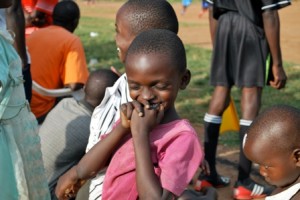 It is behind the store lined streets that I am confronted daily with the most disturbing sights. To do any justice to this scene it would require a collage of grey, red and brown paints, yet the greater challenge, despite my lack of artistic talents, would be to try to live amongst it. Houses typically consist of one to two rooms, of six by five feet dimensions, constructed primarily of either concrete slabs, mud bricks or just mud and bamboo that slowly erode under the rain. Rusting metal sheets and plastic bags are held in place by rocks that serve as roofing. Some houses have cement floors, others just have dirt, which as I walk past I see mothers endlessly sweeping in what must either be a futile attempt to promote cleanliness or a meticulous scheme to find hidden gold underground. These houses that contain six or more people are so compacted together that few vehicles can service them, surrounded by only tiny dirt lanes and alleys. The homes don’t often have electricity and gas, which are too expensive, so people burn charcoal and wood instead to cook. Water is accessed from communal taps or natural springs, collected in giant plastic containers and then transported by foot to the home. Sadly the underground water is heavily contaminated and even the water from the tap needs to be boiled, but this is not practical for a large family using a little wood burning stove. Most people in the slums use pit latrines as toilets, wait for a heavy rain downpour, and then release all the accumulated sewage so that it runs down open mud drains into the wetlands.
It is behind the store lined streets that I am confronted daily with the most disturbing sights. To do any justice to this scene it would require a collage of grey, red and brown paints, yet the greater challenge, despite my lack of artistic talents, would be to try to live amongst it. Houses typically consist of one to two rooms, of six by five feet dimensions, constructed primarily of either concrete slabs, mud bricks or just mud and bamboo that slowly erode under the rain. Rusting metal sheets and plastic bags are held in place by rocks that serve as roofing. Some houses have cement floors, others just have dirt, which as I walk past I see mothers endlessly sweeping in what must either be a futile attempt to promote cleanliness or a meticulous scheme to find hidden gold underground. These houses that contain six or more people are so compacted together that few vehicles can service them, surrounded by only tiny dirt lanes and alleys. The homes don’t often have electricity and gas, which are too expensive, so people burn charcoal and wood instead to cook. Water is accessed from communal taps or natural springs, collected in giant plastic containers and then transported by foot to the home. Sadly the underground water is heavily contaminated and even the water from the tap needs to be boiled, but this is not practical for a large family using a little wood burning stove. Most people in the slums use pit latrines as toilets, wait for a heavy rain downpour, and then release all the accumulated sewage so that it runs down open mud drains into the wetlands.
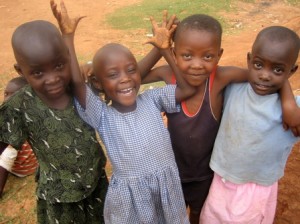 To finish off this painting I would try to capture some of the many children I see each day that are running, playing and washing outside their homes. These kids are always smiling and eagerly run up to you to shake your hands and say hello, amazing ambassadors for such a country. Half the population of Kampala is under 18 years of age, partly symptomatic of the fact that the average life expectancy is 50 years of age here, but also endemic of the fact that families still have too many children. In fact polygamy is abundant although publicly not condoned, and it is not uncommon for one man to have twenty or thirty children with many different women, then only discover each other when they attend the man’s funeral. Almost one in every ten children here dies at birth and 15% of children die before they reach the age of five. What is sadder though is not the horrendous mortality rate, the poor social services or inadequate education system, but that any child should live in such an environment and consider it normal or acceptable.
To finish off this painting I would try to capture some of the many children I see each day that are running, playing and washing outside their homes. These kids are always smiling and eagerly run up to you to shake your hands and say hello, amazing ambassadors for such a country. Half the population of Kampala is under 18 years of age, partly symptomatic of the fact that the average life expectancy is 50 years of age here, but also endemic of the fact that families still have too many children. In fact polygamy is abundant although publicly not condoned, and it is not uncommon for one man to have twenty or thirty children with many different women, then only discover each other when they attend the man’s funeral. Almost one in every ten children here dies at birth and 15% of children die before they reach the age of five. What is sadder though is not the horrendous mortality rate, the poor social services or inadequate education system, but that any child should live in such an environment and consider it normal or acceptable.
Finally, standing up after having completed my work, I would extend my arms on either side, take a deep breath and stretch every muscle in my back. Rejuvenated somewhat, I would step away from the painting, momentarily look at my work and judge it upon its merits. I would then slowly remove the canvas from its easel, crush it in my hands and throw it away, completely unsatisfied with the scene I see depicted. I honestly find it very hard to accept the living conditions and environment people here have to deal with each day. I only hope someday someone can paint a very different and better picture of this city.
Take care,
Jamie
ABOUT UNITED PLANET
United Planet is a non-profit organization with a mission to create a global community, one relationship at a time. Established in 2001, United Planet offers volunteer abroad, virtual internships, internships abroad, gap year volunteering, and global virtual exchange in more than 40 countries.



